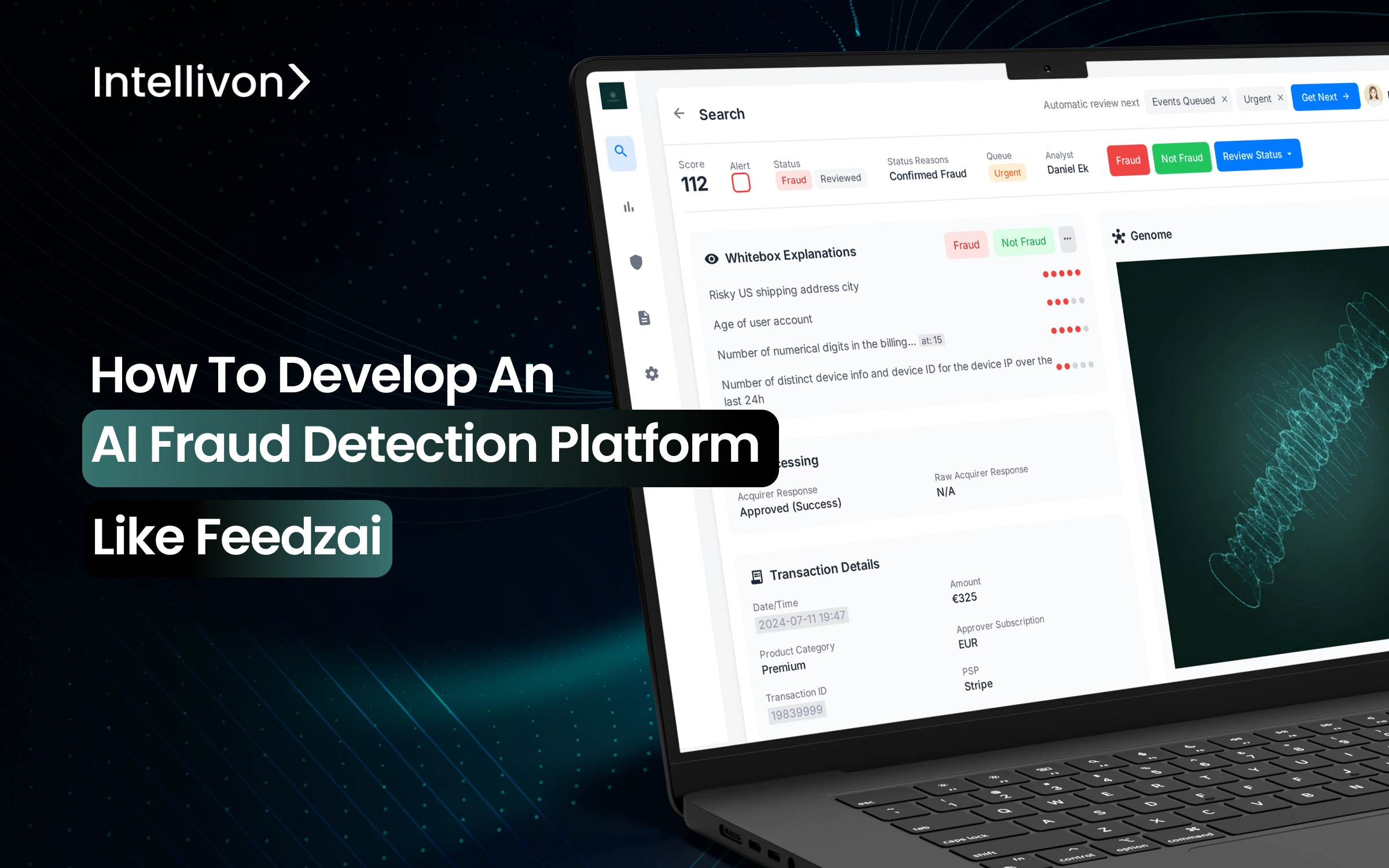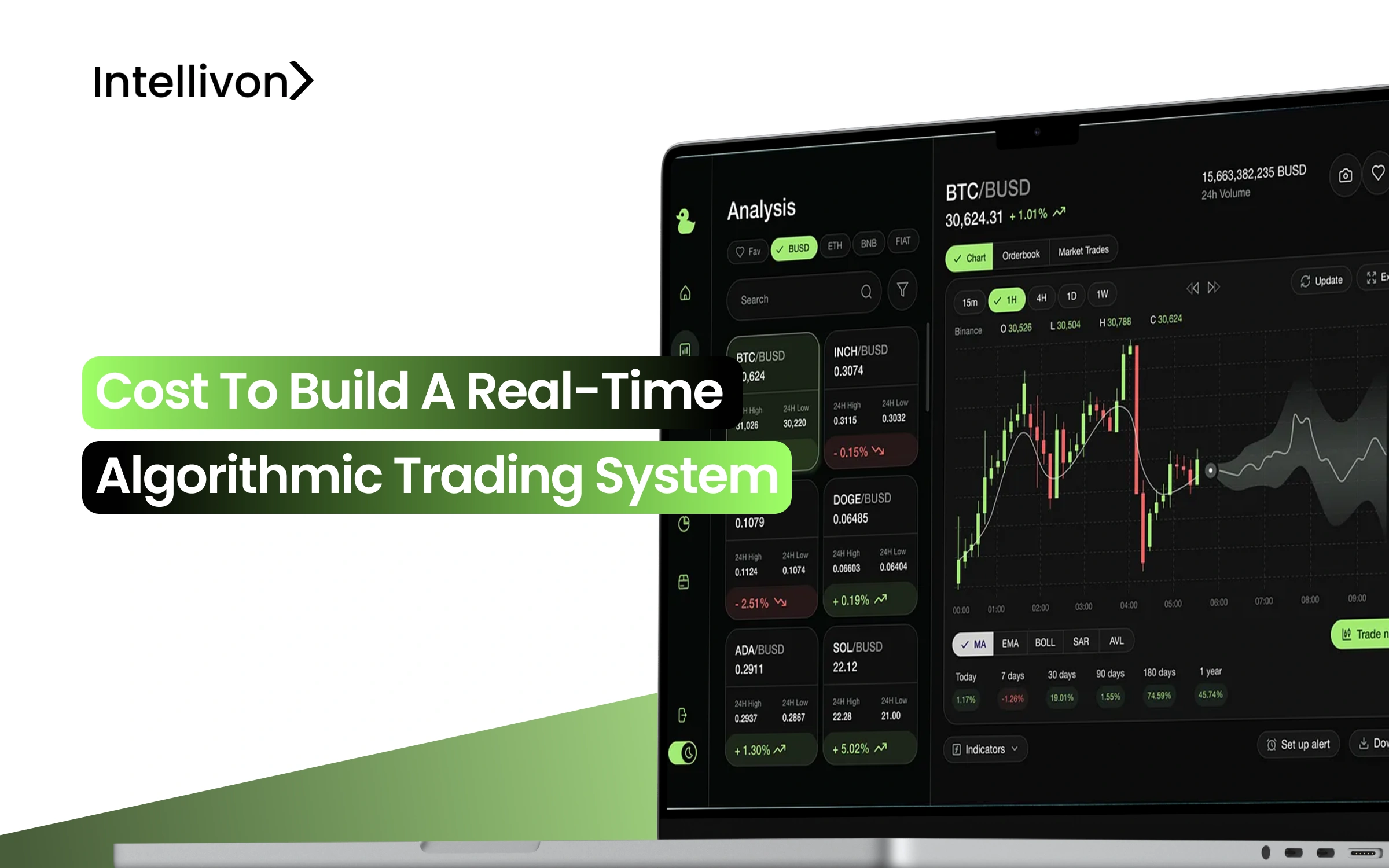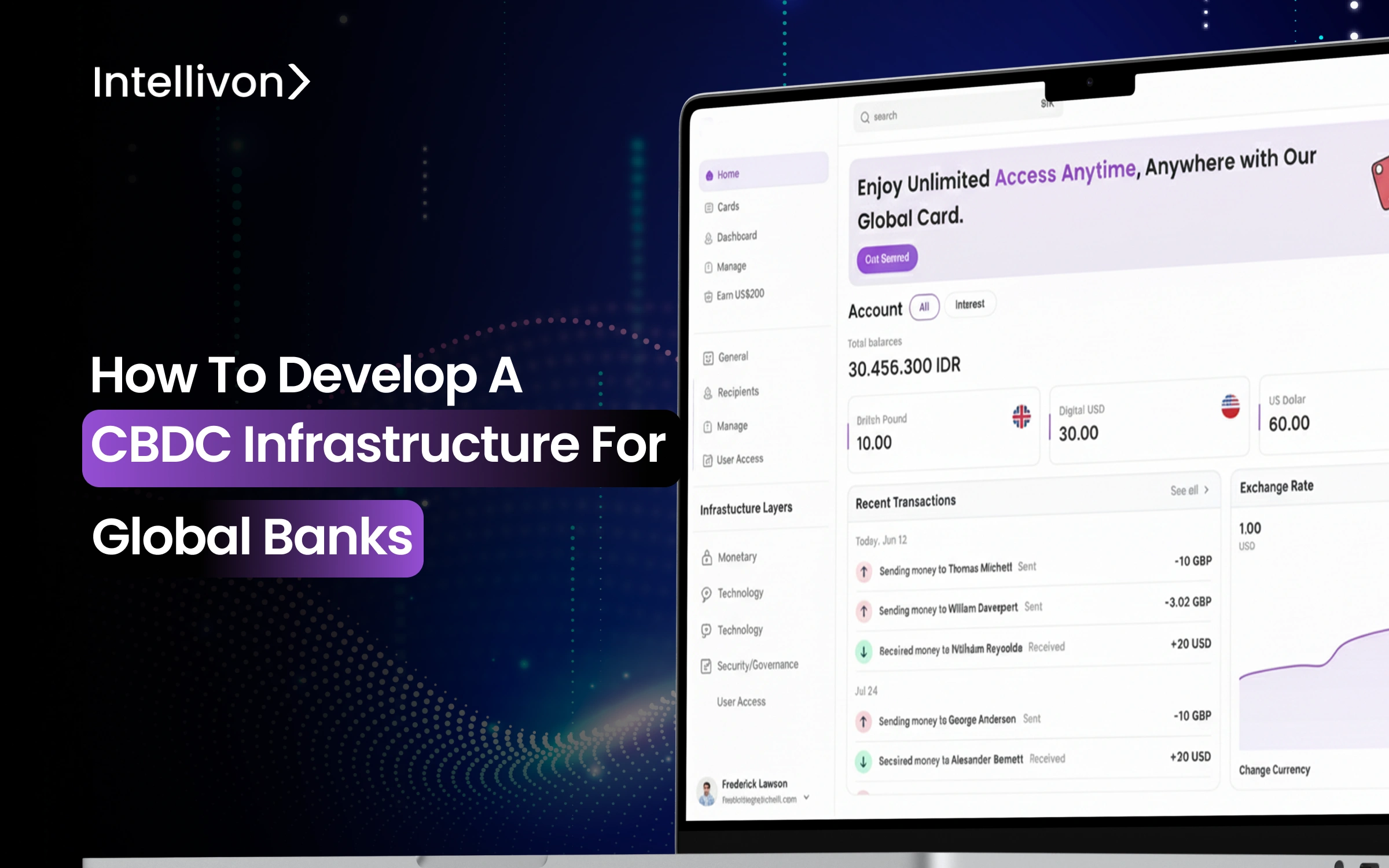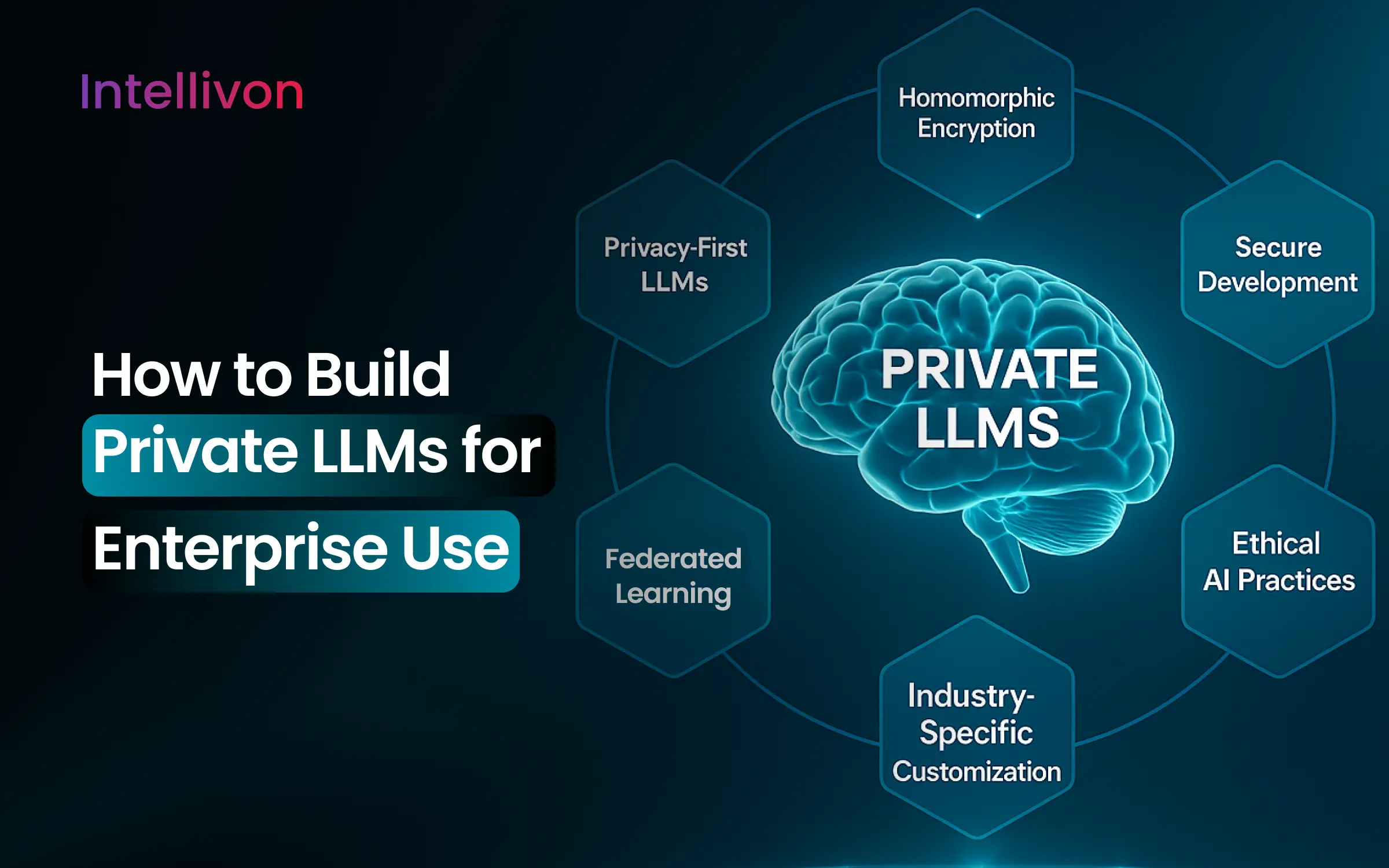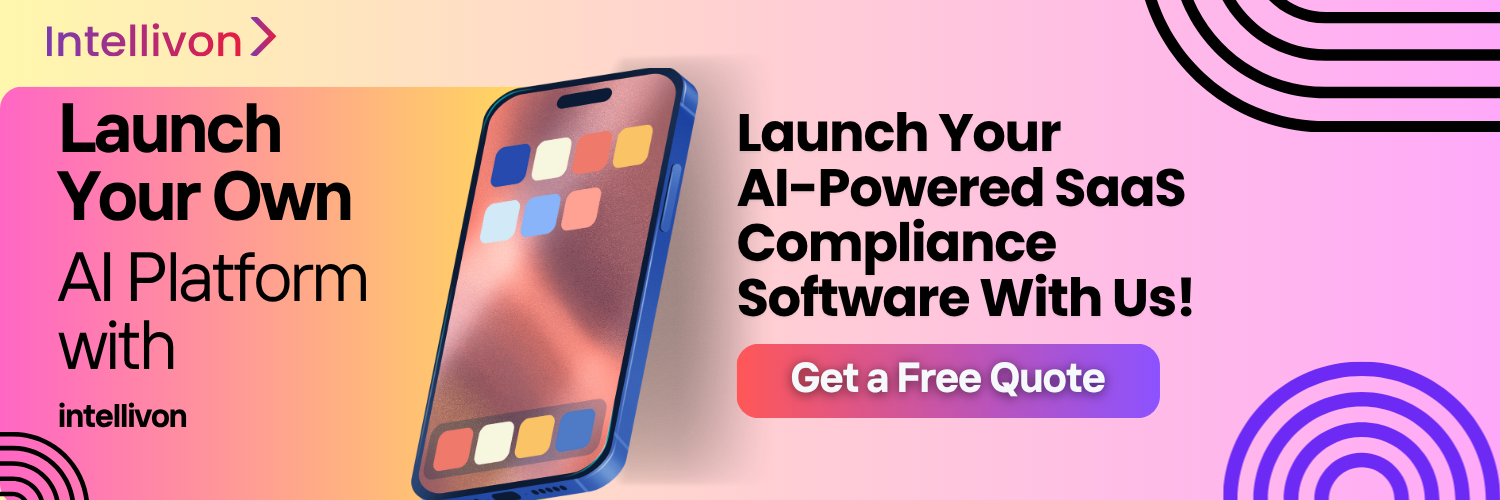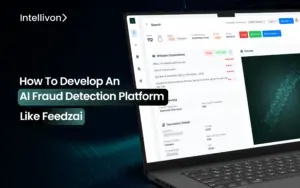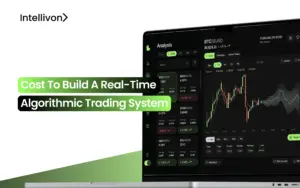The SaaS compliance landscape is undergoing significant changes, and most enterprises are unprepared to face these challenges. Now, enterprises must go beyond navigating foundational frameworks and look into emerging regulations, such as the EU AI Act. Moreover, the alarming rise in the adoption of modern SaaS architectures has created complexities that manual processes can no longer manage. This is why industry leaders are adopting AI-powered SaaS compliance software. These systems leverage machine learning to continuously monitor millions of events, predict risks, recommend remediations, and adapt to regulatory changes in real-time.
At Intellivon, we have developed AI-powered SaaS compliance platforms that help enterprises scale confidently without the added fear of compliance breaches. Our experience spans global platforms managing GDPR, HIPAA, and AI-specific regulations simultaneously. By the end of this blog, you will get a full picture of what this software is, how it fits your enterprise goals, and how we develop it from the ground up.
What Is AI-Powered SaaS Compliance Software?
In every large enterprise, dozens of SaaS apps run constantly. Microsoft 365, Salesforce, Slack, Zoom, and even AI tools like ChatGPT carry sensitive business and customer data. Each of these apps can create compliance risk if no one oversees how it’s used. Here is where AI-powered SaaS compliance software brings order to this environment.
At its core, the system monitors how these apps are used, compares activity with regulations such as GDPR, HIPAA, or PCI-DSS, and takes action the moment it spots a risk. Instead of waiting for a monthly audit, the platform responds in real time. It can catch an unauthorized login at midnight or stop a file with personal data from being shared publicly, long before it turns into a costly problem.
Unlike older compliance tools that simply log data, AI-driven platforms analyze patterns as they happen. They learn what normal usage looks like and flag unusual behavior instantly. More importantly, they don’t just notify IT and wait. They revoke risky access, lock down exposed files, or trigger corrective workflows across multiple apps on their own.
For instance, a sales manager accidentally shares a spreadsheet of client details on a public link. In older setups, auditors might notice weeks later. An AI-powered platform reacts instantly, classifying the file as sensitive, removing the public link, alerting the manager, and recording the event. The software closes the gap before any damage occurs.
Key Takeaways of the SaaS Compliance Software Market
The SaaS compliance software market is on a sharp rise. Reports show it could cross $5.7 billion by 2028, growing at more than 15% each year.
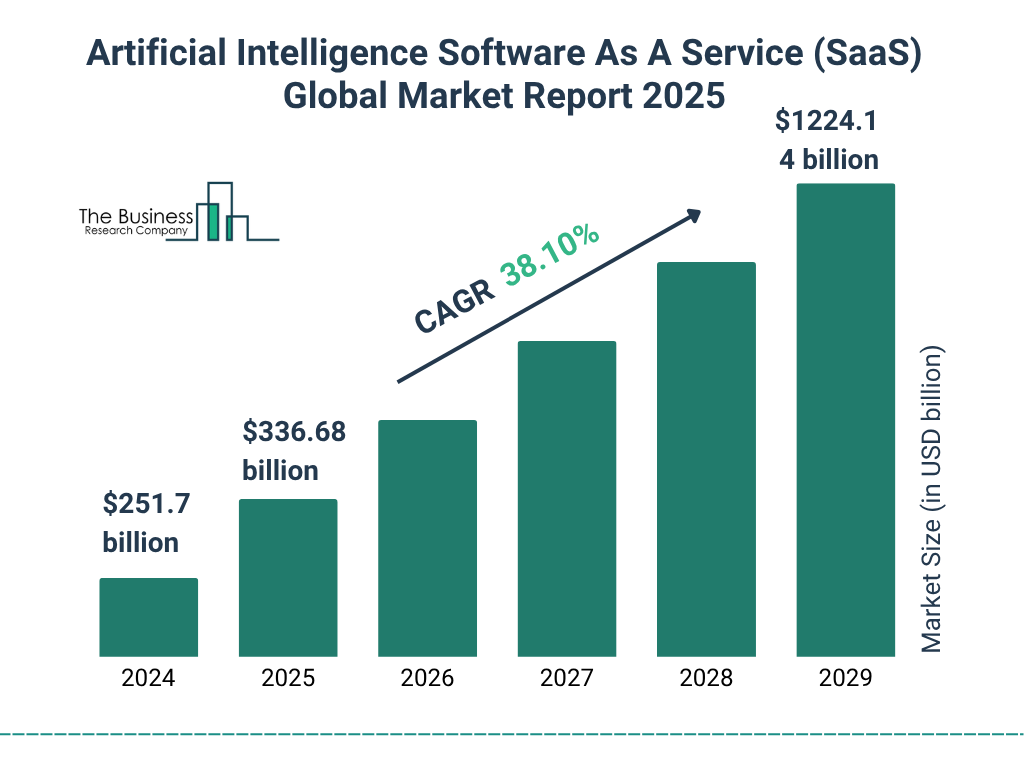
This growth comes from two forces. First, new regulations such as GDPR, CCPA, and the upcoming EU AI Act keep adding pressure. Second, enterprises in every industry now rely heavily on SaaS apps, making compliance harder to manage without automation.
- New frameworks like the EU AI Act and stricter data laws push compliance demands onto even mid-sized SaaS firms.
- In 2025, 95% of enterprises say AI adoption adds new audit and compliance risks.
- AI systems face scrutiny for legal, explainability, and bias compliance.
- Enterprises now run 275+ SaaS apps on average, with 60% handling sensitive data.
- Around 33% of SaaS apps remain shadow IT, which are hidden, unmanaged, and of high risk.
- 72% of security leaders rank automated compliance monitoring as the top budget priority for 2025.
- AI and ML cut audit prep time by up to 60% through real-time evidence collection.
- Machine learning improves anomaly detection, document mapping, and control testing accuracy.
- Market leaders embed GenAI and LLM-based agents to scan code, review contracts, and track regulatory changes automatically.
Key Regulations AI-Powered SaaS Compliance Software Covers
Enterprises rarely operate within one legal framework. A global business may store customer data in Europe, process payments in North America, and run healthcare operations in Asia. AI-powered SaaS compliance software helps organizations manage this complexity by aligning app usage with the regulations that matter most.
1. GDPR
GDPR sets strict rules for handling personal data. The software enforces data residency, monitors consent, and supports the right to erasure so enterprises avoid steep fines.
2. HIPAA
HIPAA demands strong protection for patient records. AI compliance platforms track how SaaS apps handle medical data, flag risky sharing, and ensure only approved users gain access.
3. SOX (Sarbanes-Oxley Act)
SOX focuses on financial data integrity. The platform builds automated audit trails, controls user permissions, and spots anomalies in SaaS-based financial reporting systems.
4. PCI-DSS (Payment Card Industry Data Security Standard)
PCI-DSS governs credit card and payment data. Compliance software checks SaaS payment tools for secure configurations, valid integrations, and unusual activity that could signal fraud.
5. SOC 2 and ISO 27001
These frameworks set global standards for security and trust. The platform verifies encryption, role-based access, and vendor certifications across the SaaS stack.
6. Regional Privacy Laws
Local laws like California’s CCPA create region-specific obligations. AI-driven compliance systems adapt monitoring based on geography, ensuring local requirements are met without slowing down operations.
What Happens If Enterprises Don’t Comply?
Non-compliance creates financial losses, reputational harm, and operational setbacks that can take years to recover from. Regulations today are designed with real penalties, and enforcement is becoming stricter every year.
1. Heavy Financial Penalties
Fines are significant and often public. Under GDPR, penalties can reach up to 4% of annual global revenue. PCI-DSS and HIPAA violations also carry multi-million-dollar costs that quickly outweigh the investment in compliance systems.
2. Reputational Damage
Customers lose trust when their data is exposed. Even a single breach can push clients toward competitors who can prove stronger compliance. Rebuilding reputation after such an incident costs far more than preventing it.
3. Legal and Contractual Risks
Non-compliance often brings lawsuits, class actions, and lengthy legal disputes. Enterprises may also lose contracts if they cannot prove compliance during vendor assessments or government bids.
4. Operational Disruption
Regulators can restrict or suspend business operations until compliance gaps are resolved. For SaaS-heavy enterprises, even short disruptions can cripple productivity across departments and markets.
How AI-Powered SaaS Compliance Software Works Inside Enterprises
Enterprises often rely on hundreds of SaaS tools spread across different departments. Every login, file share, or integration creates the potential for compliance risk. AI-powered SaaS compliance software works as the control layer that connects these tools, enforces rules, and responds to risks in real time.
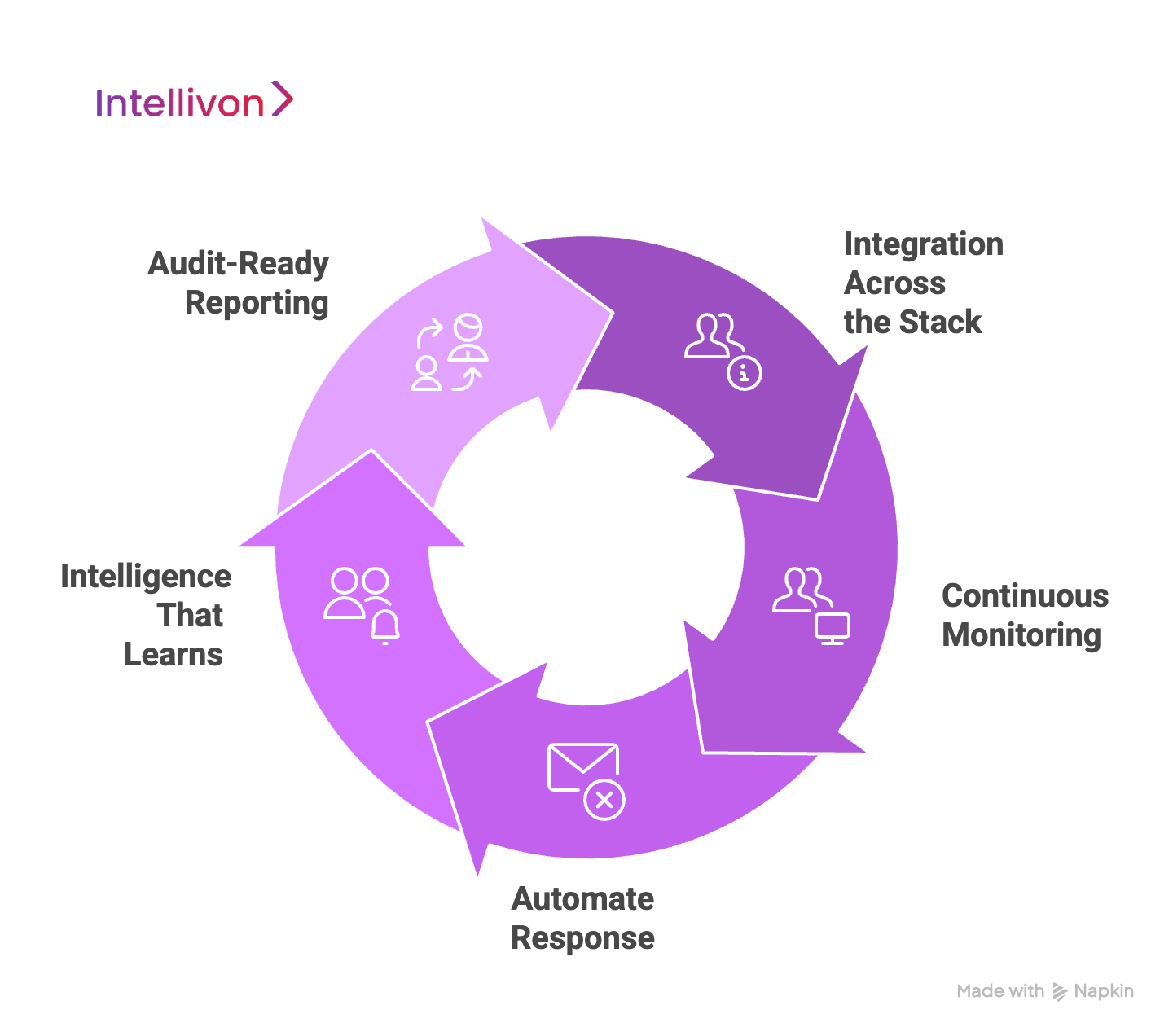
1. Integration Across the Stack
The process begins with integration. Here, the platform connects to identity providers like Okta or Azure AD, as well as HR and finance systems. It also links directly to SaaS apps through APIs. With this foundation, enterprises gain a unified view of who uses which tools, what data flows through them, and how each system is configured.
2. Continuous Monitoring
Once connected, the software starts monitoring activity continuously. Instead of relying on quarterly checks, it tracks logins, permissions, and data transfers as they occur. These events are then compared against compliance frameworks such as GDPR, HIPAA, or PCI-DSS. This live oversight ensures risks don’t sit unnoticed.
3. Automated Response
The real advantage comes when the platform detects something risky. Through automation, it can revoke access, restrict unusual downloads, or remove public file links within seconds. This instant response closes gaps long before manual processes would have even flagged them.
4. Intelligence That Learns
Machine learning adds another layer of strength. Over time, the platform learns what normal activity looks like and reduces false alerts. As new regulations appear, the policy engine updates automatically, ensuring the enterprise stays aligned without rebuilding controls from scratch.
5. Audit-Ready Reporting
Finally, the software creates a reliable audit trail. All actions and corrections are logged in dashboards that leaders can review at any time. When auditors arrive, the evidence is already organized, removing the stress of last-minute preparation.
By integrating, monitoring, and responding in real time, these platforms transform compliance from a reactive process into a continuous safeguard.
Core Features of an AI-Powered SaaS Compliance Platform
An enterprise-grade compliance platform blends intelligence, automation, and reporting into a single system that keeps pace with the scale and speed of today’s SaaS usage. Here are the core features with which these AI-powered SaaS compliance platforms are built:
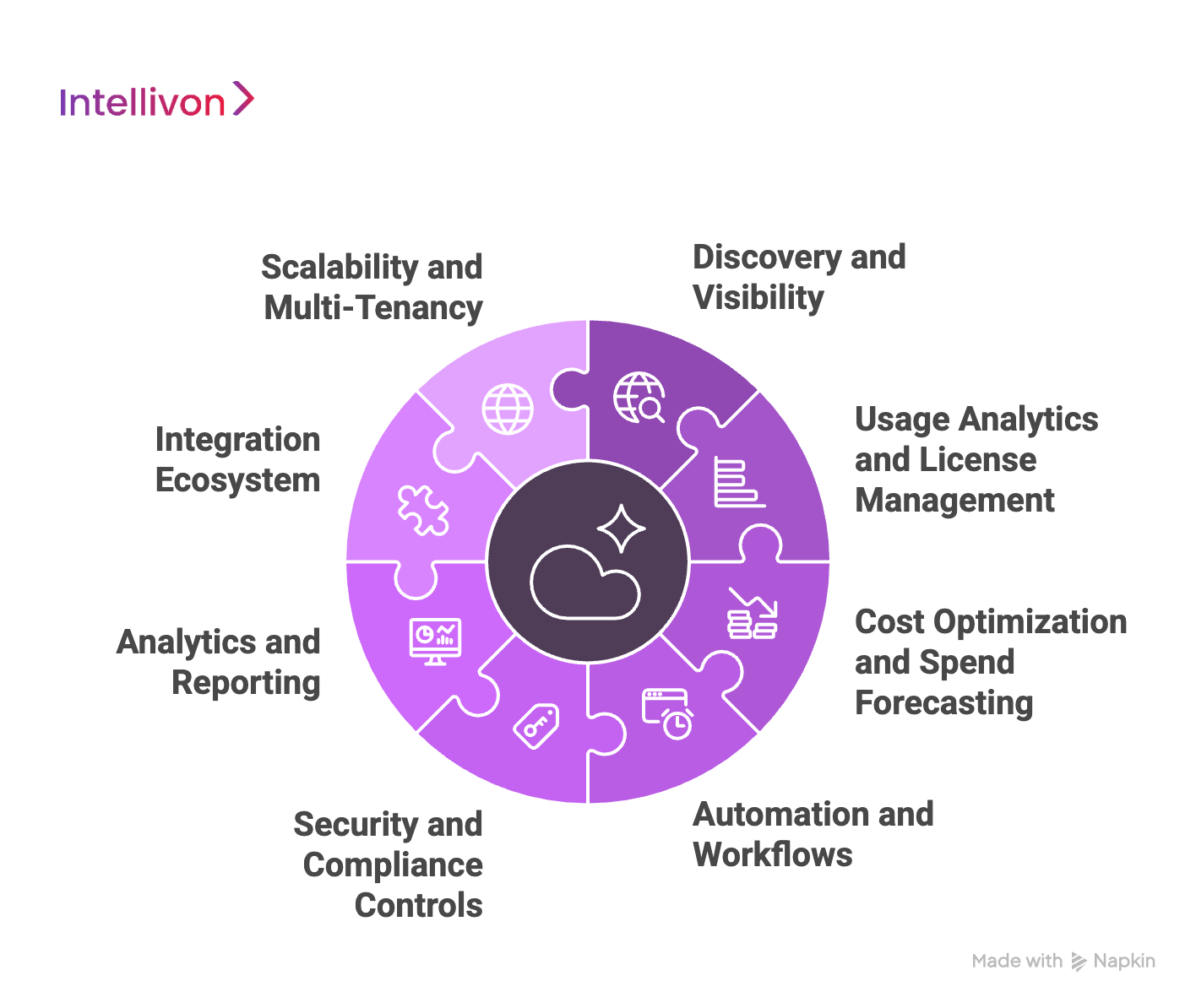
1. Discovery and Visibility
Every enterprise has apps running outside IT’s direct control. A strong platform brings them into view by connecting with identity providers, HR systems, finance tools, and expense reports. This creates a live inventory of apps, users, and data flows, which makes up the foundation for compliance oversight.
2. Usage Analytics and License Management
Knowing how employees actually use software is just as important as knowing what software exists. The platform highlights feature-level usage, spots inactive accounts, and matches licenses to real demand. This prevents both wasted spend and unnecessary access risk.
3. Cost Optimization and Spend Forecasting
Enterprises lose millions each year to auto-renewals and poor vendor terms. Compliance platforms help by flagging renewals in advance, benchmarking costs, and projecting spend based on usage trends. Procurement teams gain leverage, and finance teams can plan with fewer surprises.
4. Automation and Workflows
Manual compliance work slows everyone down. Automation takes over repetitive tasks like offboarding users across multiple apps, revoking risky permissions, or auto-approving access requests within policy. These workflows cut response times from days to seconds while reducing human error.
5. Security and Compliance Controls
Most compliance gaps stem from weak access control or careless data sharing. The platform enforces granular permissions, tracks how files move, and checks vendor certifications automatically. It keeps every SaaS tool aligned with frameworks like GDPR, HIPAA, and PCI-DSS.
6. Analytics and Reporting
Audits are painful when evidence is scattered. Compliance software consolidates logs and actions into dashboards that leaders can read at a glance. It also generates audit-ready reports that cut preparation time and give regulators the proof they expect.
7. Integration Ecosystem
No enterprise stack is uniform. The value of these platforms lies in wide connector libraries and flexible APIs that bring even niche or legacy apps under control. Middleware bridges fill gaps so no system is left unmanaged.
8. Scalability and Multi-Tenancy
Large organizations run across regions, teams, and subsidiaries. A compliance platform must scale with them. Multi-tenant architecture allows global oversight while preserving local control, ensuring the framework grows as the SaaS footprint expands.
These features work together to give enterprises a single system of control over their entire SaaS stack. From discovery to reporting, each capability reduces risk, improves efficiency, and makes compliance manageable at scale. The real test, however, is how these features translate into practical outcomes, which becomes clear when looking at the top enterprise use cases.
Enterprise Use Cases of AI-Powered SaaS Compliance Software
While features describe what the platform can do, use cases show how enterprises actually benefit from it in practice. These scenarios highlight where compliance software creates immediate value and long-term impact.
1. Onboarding and Offboarding Automation
Every time an employee joins or leaves, dozens of SaaS accounts need adjustment. The platform automates this process, granting role-based access on day one and removing permissions instantly when someone exits. This reduces risk, prevents dormant accounts, and saves hours of manual work.
2. License Optimization
Unused or underutilized licenses drain budgets and create unnecessary exposure. AI-powered SaaS compliance platforms track real usage and rightsize licenses across the stack. This ensures employees keep access to what they need while eliminating waste, often cutting SaaS spend by double-digit percentages.
3. Contract and Renewal Management
Auto-renewals catch enterprises off guard, often locking them into unfavorable terms. The compliance software flags contracts in advance, benchmarks pricing, and provides usage data for negotiations. Procurement teams go into renewal talks with leverage instead of surprises.
4. Shadow IT Detection
Unmonitored tools often slip into workflows, carrying sensitive data outside IT’s control. The platform identifies these shadow apps, assesses their risk, and either integrates them into governance or blocks them outright. This restores visibility and protects against hidden audit failures.
5. Security and Data Governance
File sharing is one of the most common compliance risks. The software monitors how sensitive documents move across apps, blocks risky public links, and enforces encryption. Enterprises gain assurance that data stays within approved boundaries.
6. Cross-SaaS Workflows
Some compliance actions span multiple tools. For example, revoking a departing employee’s access may touch CRM, messaging, and file storage. The platform orchestrates these steps automatically, creating end-to-end workflows that keep compliance tight without slowing productivity.
7. Audit-Ready Reporting
Preparing for audits often means pulling records from dozens of systems. AI-powered compliance platforms consolidate this into dashboards that show risks addressed, policies enforced, and activity logs. Instead of rushing to collect evidence, enterprises present a clean, ready-made audit trail.
These use cases prove the platform’s value is not theoretical. They address real gaps that enterprises face daily, from license waste to regulatory audits. With use cases established, the next step is understanding how these platforms are built and the architecture that makes them work.
Architecture of an AI-Powered SaaS Compliance Software
At Intellivon, we design compliance platforms with a layered architecture built for scale, security, and adaptability. Each layer serves a clear purpose, and together they deliver the foundation enterprises need to manage compliance across hundreds of SaaS tools in real time.
1. Data Ingestion and Integration
Our architecture begins with deep integrations. We connect with identity providers, HR and finance systems, and SaaS apps through APIs. This allows us to pull in usage data, logs, and user activity, creating a live and unified foundation.
2. Data Processing and Normalization
Raw data often arrives fragmented and inconsistent. We normalize it into a common model for users, roles, licenses, and events. This step ensures that policies apply consistently across every connected tool in the enterprise stack.
3. Intelligence Layer
This is where Intellivon’s AI models come into play. Machine learning detects anomalies, scores risks, and learns from usage patterns. Our rule engines map enterprise activity against frameworks like GDPR, HIPAA, and PCI-DSS to spot issues before they escalate.
4. Automation and Workflow Orchestration
The automation layer executes corrective actions instantly. Whether revoking access, removing risky file links, or triggering workflows across multiple apps, our system enforces compliance in real time, and not after the fact.
5. Security and Compliance Controls
Every platform we build is security-first. We embed encryption, role-based access, audit logging, and policy enforcement into the core. This guarantees sensitive data stays protected while creating the evidence trail regulators demand.
6. Analytics and Reporting
Enterprises need clarity to act. Our reporting layer converts activity into dashboards and audit-ready reports for leadership. Forecasting tools highlight emerging risks and prepare teams ahead of audits, saving time and effort.
7. User Experience Layer
Technology only works if people use it. Our UX layer offers intuitive dashboards, admin consoles, and self-service portals while exposing APIs for enterprises that want to extend the platform.
Intellivon’s layered architecture gives enterprises a compliance system that sees, acts, and proves. By blending intelligence with automation, our platform turns compliance into a continuous safeguard.
How We Develop AI-Powered SaaS Compliance Software
At Intellivon, we take a structured yet flexible approach to building compliance platforms. Our process ensures enterprises gain a system that adapts to scale, enforces policies reliably, and delivers measurable business value. Each step builds toward a platform that not only monitors compliance but also actively protects it.
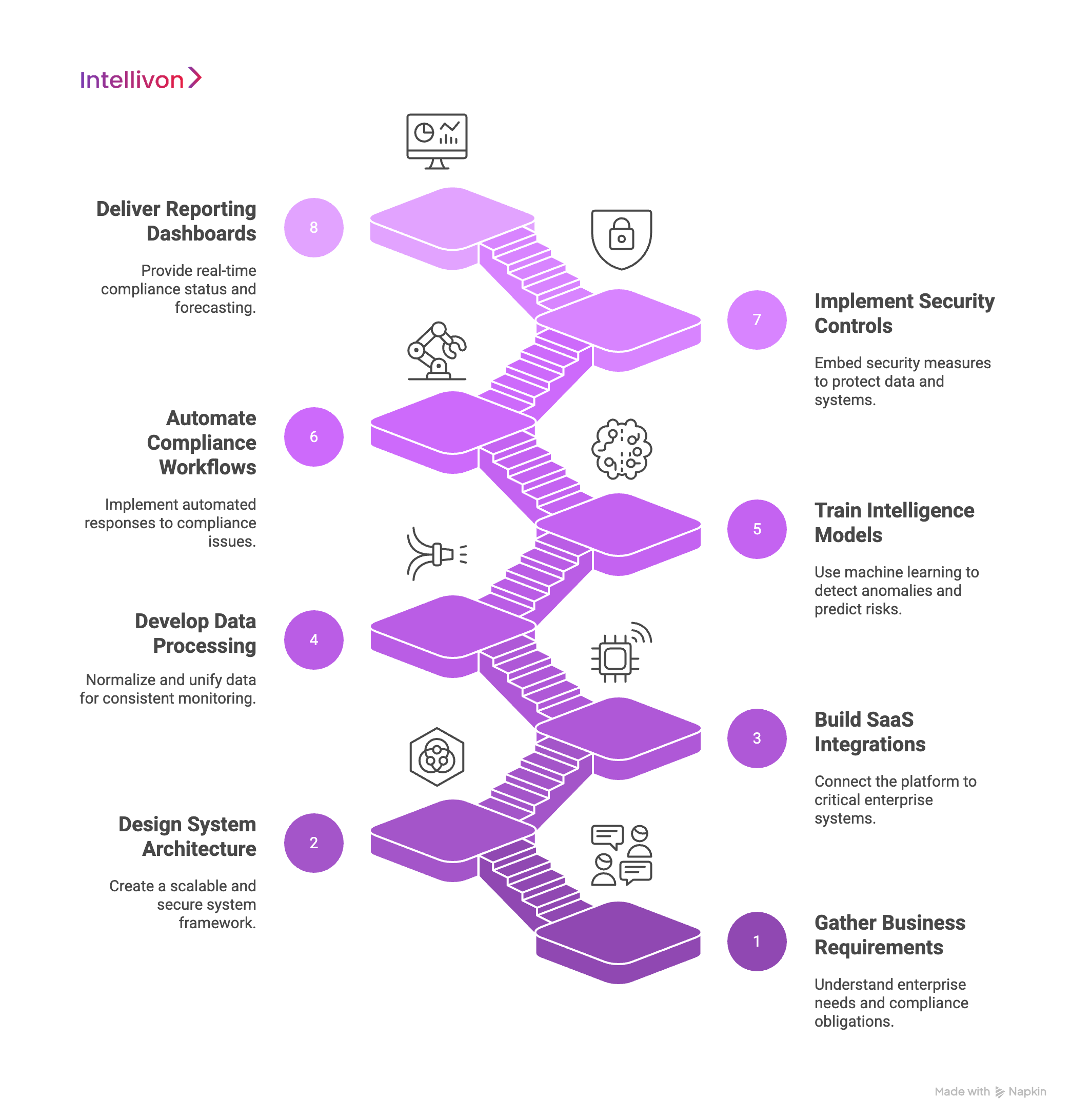
1. Gather Business Requirements
We start by understanding the enterprise in depth. This means running workshops with stakeholders to capture compliance obligations, identifying current gaps, and analyzing the SaaS ecosystem in use.
Every enterprise has a different mix of tools, regulations, and risk priorities. By mapping these factors early, we ensure the platform reflects real-world needs rather than a generic template.
2. Design System Architecture
Once requirements are clear, our architects design the framework that will support compliance at scale. We create a layered, cloud-native system that blends integrations, intelligence, automation, and reporting. The design focuses on resilience, scalability, and security.
This step is critical because the architecture determines how well the platform can handle hundreds of SaaS apps without breaking compliance rules.
3. Build SaaS Integrations
Integration is where visibility begins. We connect the platform to identity providers, HR and finance systems, and the enterprise’s most critical SaaS applications. Our integration work ensures the system captures logins, permissions, and data flows in real time.
Without this layer, compliance monitoring remains fragmented. With it, enterprises gain a complete, connected view across their SaaS stack.
4. Develop Data Processing
SaaS data is messy by nature. Different apps record events in different formats, which makes compliance monitoring inconsistent. We solve this by building a processing layer that cleans and normalizes the data into a unified structure. Every user, license, role, and action becomes comparable across applications.
This step gives the platform the clarity it needs to apply policies evenly.
5. Train Intelligence Models
The intelligence layer is what makes the platform proactive. We train machine learning models to detect anomalies, predict risks, and map activities against compliance frameworks such as GDPR, HIPAA, and PCI-DSS.
These models learn from patterns over time, reducing false positives and improving accuracy. Instead of waiting for audits, enterprises gain compliance insight the moment an issue arises.
6. Automate Compliance Workflows
Manual compliance tasks are slow and error-prone. That’s why we design workflows that respond automatically. If a departing employee still has access, the system revokes it. If a file with sensitive data is shared publicly, the link is removed instantly.
Multi-app orchestration ensures that actions ripple across all affected tools. The result is faster response times and fewer blind spots.
7. Implement Security Controls
Compliance is inseparable from security. At Intellivon, we embed security controls directly into the platform. This includes encryption for data at rest and in transit, strict role-based access, and detailed audit logging.
By building these controls into the foundation of the software rather than layering them on later, we ensure the platform meets international security standards from day one.
8. Deliver Reporting Dashboards
Enterprises need visibility, not just automation. That’s why we deliver audit-ready dashboards that summarize compliance status in real time. Leaders can track risk levels, view historical actions, and export reports directly for audits.
Forecasting tools also help predict potential compliance gaps before they become issues. With reporting built in, enterprises no longer scramble for evidence during audits.
Through these steps, Intellivon creates AI-powered SaaS compliance software that is practical, scalable, and aligned with enterprise goals. Each layer, from integrations to reporting, works together to enforce compliance in real time.
With development mapped out, the next challenge is deployment, where enterprises often face integration, adoption, and scaling hurdles.
Cost of Developing AI-Powered SaaS Compliance Software
At Intellivon, we recognize that enterprises need compliance platforms that are both secure and cost-effective. That’s why our pricing approach is designed to stay flexible and aligned with your requirements, not a one-size-fits-all package.
If projected costs risk exceeding your planned budget, we collaborate with you to streamline the scope while safeguarding the core value of compliance, security, and efficiency.
Estimated Phase-Wise Cost Breakdown
| Phase | Description | Estimated Cost Range (USD) |
| Discovery and Strategy | Requirement gathering, KPI alignment, regulatory mapping (GDPR, HIPAA, PCI-DSS, SOX). | $6,000 – $10,000 |
| Architecture and Design | System blueprint, data flows, integration planning (identity, SaaS apps, HRIS, finance). | $8,000 – $14,000 |
| AI Model Development | Machine learning for anomaly detection, risk scoring, policy mapping, and audit prep. | $10,000 – $18,000 |
| Platform Customization | Dashboards, automation workflows, compliance rule engine, and reporting modules. | $12,000 – $20,000 |
| Security Alignment | Encryption, RBAC, audit trails, continuous validation against GDPR, and HIPAA. | $6,000 – $12,000 |
| Testing and Validation | Security audits, performance tests, compliance checks, and accuracy tuning. | $4,000 – $8,000 |
| Deployment and Scaling | Cloud rollout, monitoring dashboards,and region-specific compliance configurations. | $5,000 – $10,000 |
Total Initial Investment Range: $50,000 – $100,000
Ongoing Optimization (Annual): $5,000 – $10,000
Factors That Influence Cost
- Number of integrations: Identity, finance, and SaaS app connectors.
- Model complexity: Simple anomaly detection vs. advanced predictive compliance.
- Regulatory scope: Coverage for GDPR only vs. multi-framework compliance.
- Deployment model: Cloud-native, hybrid, or on-premises.
- Customization depth: Standard dashboards vs. fully tailored workflows.
- Advanced features: Continuous audit automation, bias testing for AI, and multi-region scaling.
Request a tailored quote from Intellivon’s AI engineers today. We’ll design a SaaS compliance platform that aligns with your budget, strengthens governance, and scales with your operations.
Overcoming Challenges Enterprises Face in Deploying The Software
Even the best compliance platform faces hurdles during deployment. Large enterprises deal with legacy systems, fragmented data, and organizational resistance. Understanding these challenges upfront helps leaders prepare for smoother adoption.
1. Data and Integration Complexity
Enterprises rarely run on a clean SaaS stack. They often juggle hundreds of tools with inconsistent APIs, duplicate data, and hidden integrations. Without proper planning, bringing this ecosystem under one compliance system can slow projects and leave blind spots.
Intellivon’s Solution
We prioritize integration during early design. Our platform connects through pre-built APIs, middleware, and custom connectors where needed. By normalizing data before applying policies, we reduce inconsistencies and ensure compliance monitoring covers the entire SaaS landscape.
2. Accuracy of Usage Data
Compliance relies on accurate insights. Yet many SaaS tools offer incomplete or shallow logs, leaving gaps in monitoring. Enterprises risk making decisions based on partial data.
Intellivon’s Solution
Our platform enriches app data with signals from identity providers, HR, and finance systems. This multi-source approach closes gaps, creating a reliable picture of SaaS usage and compliance status across the enterprise.
3. Security and Compliance Reviews
Enterprises operate under multiple regulations at once. Each new tool or workflow must be reviewed for GDPR, HIPAA, PCI-DSS, or other standards. Manual reviews are slow and prone to oversight.
Intellivon’s Solution
We embed compliance rules directly into the platform. Automated checks run continuously, so each SaaS app is reviewed in real time against the right frameworks. This reduces audit fatigue and speeds up approvals.
4. Workflow Customization Difficulties
Every enterprise has unique needs. Out-of-the-box compliance workflows often fail to match business processes, forcing IT teams to patch systems manually.
Intellivon’s Solution
Our no-code workflow builder lets enterprises design policies that reflect their structure. Whether automating offboarding or restricting file sharing, workflows adapt without complex coding or long development cycles.
5. Vendor and Contract Migration
Migrating licenses and compliance records from legacy systems or old vendors often slows adoption. Enterprises worry about losing data or disrupting audits during the transition.
Intellivon’s Solution
We handle migrations through structured onboarding. Our process includes data mapping, parallel testing, and gradual cutovers, ensuring continuity while moving to the new platform. Enterprises keep their audit history intact without downtime.
6. Scaling Across Global Operations
Global enterprises run SaaS tools across regions, each with unique data laws. Scaling compliance across borders without breaking local rules is a major challenge.
Intellivon’s Solution
Our platform supports multi-tenancy with region-specific controls. Local data laws are enforced where relevant, while global oversight remains intact. This structure allows enterprises to scale without risking violations.
Deployment challenges are real, but they are not barriers when addressed with the right approach. By combining flexible integrations, user-friendly workflows, and fast ROI, Intellivon ensures enterprises can adopt compliance platforms without disruption.
Conclusion
Enterprises can no longer afford to treat SaaS compliance as a reactive checklist. With hundreds of applications, rising regulations, and the rapid adoption of AI tools, manual monitoring simply cannot keep up.
AI-powered SaaS compliance software provides the foundation for continuous oversight, real-time remediation, and audit-ready transparency. It safeguards sensitive data, reduces compliance costs, and frees teams to focus on growth.
Build Your AI-Powered SaaS Compliance Software With Us
At Intellivon, we design enterprise-grade SaaS compliance platforms that are intelligence-driven, security-first, and tailored to your business needs. Our approach blends AI-powered monitoring, automated workflows, and scalable architecture to help you stay ahead of regulations without slowing down innovation.
Why partner with Intellivon?
- Tailored to Enterprise Reality: We don’t deliver generic platforms. Every build reflects your SaaS ecosystem, regulatory scope, and growth priorities, ensuring solutions that work in practice, not just on paper.
- Compliance Engineered from Day One: Our platforms embed global and regional frameworks like GDPR, HIPAA, PCI-DSS, and SOX directly into workflows, giving you audit-readiness from the moment of deployment.
- Strategic Experience You Can Trust: We’ve built AI-powered platforms across high-regulation industries, delivering measurable ROI, faster audit cycles, and reduced compliance costs for enterprises at scale.
- Architecture That Scales With You: Cloud-native and API-driven, our systems adapt as your SaaS footprint expands globally, eliminating rework while maintaining resilience and compliance continuity.
Book a discovery call with Intellivon today. Secure your competitive edge with a SaaS compliance platform that not only protects your enterprise but also strengthens trust, accelerates growth, and positions you ahead of the market.
FAQs
Q1. Is AI-powered SaaS compliance software only for highly regulated industries?
A1. No. While healthcare, finance, and insurance were early adopters, every enterprise now faces compliance risks due to SaaS sprawl and evolving data privacy laws.
Q2. How quickly can enterprises deploy a compliance platform?
A2. Timelines depend on integrations and scope, but most enterprises see a functional rollout within three to four months, with quick wins available earlier.
Q3. Can this integrate with legacy systems like old ERPs or HR platforms?
A3. Yes. We use APIs, middleware, and data bridges to bring legacy systems into the compliance framework without disrupting ongoing operations.
Q4. What ROI should enterprises expect?
A4. Enterprises typically see savings from reduced audit costs, optimized SaaS licenses, and fewer compliance violations, which are benefits that often outweigh the initial investment within the first year.
Q5. How does Intellivon handle evolving regulations?
A5. Our platforms update automatically with new regulatory frameworks. AI-driven policy engines adapt quickly, ensuring your enterprise remains compliant as rules and standards evolve.

